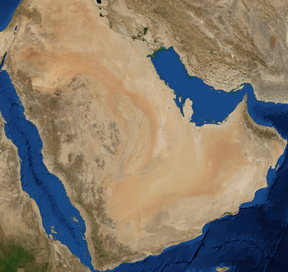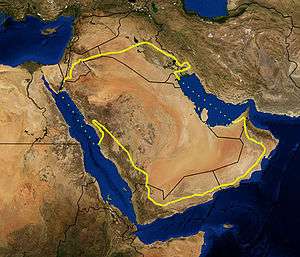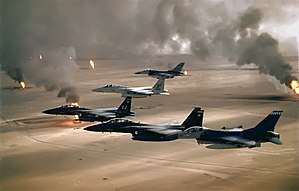Arabian Desert
The Arabian Desert (Arabic: ٱلصَّحْرَاء ٱلْعَرَبِيَّة) is a vast desert wilderness in Western Asia. It stretches from Yemen to the Persian Gulf and Oman to Jordan and Iraq. It occupies most of the Arabian Peninsula, with an area of 2,330,000 square kilometers (900,000 sq mi). It is the fifth largest desert in the world, and the largest in Asia. At its center is Ar-Rub'al-Khali (The Empty Quarter), one of the largest continuous bodies of sand in the world.
| Arabian Desert | |
|---|---|
 A satellite image of the Arabian Desert by NASA World Wind | |
| Length | 2,100 km (1,300 mi) |
| Width | 1,100 km (680 mi) |
| Area | 2,330,000 km2 (900,000 sq mi) |
| Naming | |
| Native name | ٱلصَّحْرَاء ٱلْعَرَبِيَّة (Arabic) |
| Geography | |
| Countries | List
|
| Coordinates | 18.2672°N 42.3681°E |
Gazelles, oryx, sand cats, and spiny-tailed lizards are just some of the desert-adapted species that survive in this extreme environment, which features everything from red dunes to deadly quicksand. The climate is mostly dry (the major part receives around 100 mm (3.9 in) of rain per year but some very rare places receive as little as 50 mm), and temperatures oscillate between very high heat and seasonal night time freezes. It is part of the deserts and xeric shrublands biome and the Palearctic realm.
The Arabian desert ecoregion holds little biodiversity, although a few endemic plants grow here. Many species, such as the striped hyena, jackal and honey badger have become extirpated due to hunting, human encroachment and habitat destruction. Other species have been successfully re-introduced, such as the Arabian sand gazelle, and are protected at a number of reserves. Overgrazing by livestock, off-road driving, and human destruction of habitat are the main threats to this desert ecoregion.
Geology and geography

Detailed geological features:
- A corridor of sandy terrain known as the Ad-Dahna desert connects the large An-Nafud desert (65,000 km2 or 40,389 square miles) in the north of Saudi Arabia to the Rub' Al-Khali in the south-east.
- The Tuwaiq escarpment is a region of 800 km (500 mi) arc of limestone cliffs, plateaux, and canyons.
- Brackish salt flats: the quicksands of Umm al Samim
- The Wahiba Sands of Oman: an isolated sand sea bordering the east coast[4][5]
- The Rub' Al-Khali[6] desert is a sedimentary basin elongated on a south-west to north-east axis across the Arabian Shelf. At an altitude of 1,000 metres (3,300 ft), the rock landscapes yield the place to the Rub' al-Khali, vast wide of sand of the Arabian desert, whose extreme southern point crosses the centre of Yemen. The sand overlies gravel or Gypsum Plains and the dunes reach maximum heights of up to 250 m (820 ft). The sands are predominantly silicates, composed of 80 to 90% of quartz and the remainder feldspar, whose iron oxide-coated grains color the sands in orange, purple, and red.
Ecology and natural resources
Natural resources available in the Arabian Desert include oil, natural gas, phosphates, and sulfur.
The Rub'al-Khali has very limited floristic diversity. There are only 37 plant species, 20 recorded in the main body of the sands and 17 around the outer margins. Of these 37 species, one or two are endemic. Vegetation is very diffuse but fairly evenly distributed, with some interruptions of near sterile dunes. Some typical plants are:
- Calligonum crinitum on dune slopes
- Cornulaca arabica (saltbush)
- Salsola stocksii (saltbush)
- Cyperus conglomeratus
Other widespread species are:
- Dipterygium glaucum
- Limeum arabicum
- Zygophyllum mandavillei (Mandaville 1986).
Very few trees are found except at the outer margin (typically Acacia ehrenbergiana and Prosopis cineraria). Other species are a woody perennial Calligonum comosum, and annual herbs such as Danthonia forskallii.
The Asiatic cheetah[7] and lion[8] used to be here.
Climate
The Arabian Desert has a subtropical, hot desert climate, similar to the climate of the Sahara Desert; the world's largest hot desert. The Arabian Desert is actually an extension of the Sahara Desert over the Arabian peninsula. The climate is mainly hot and dry with plenty of sunshine throughout the year. The rainfall amount is generally around 100 mm (3.9 in), and the driest areas can receive between 30 and 40 mm (1.6 in) of annual rain. Such dryness remains rare throughout the desert, however. There are few hyperarid areas in the Arabian Desert, in contrast with the Sahara Desert, where more than half of the area is hyperarid (annual rainfall below 50 mm (2.0 in)). The sunshine duration in the Arabian Desert is very high by global standards, between 2,900 hours (66.2% of daylight hours) and 3,600 hours (82.1% of daylight hours), but it is typically around 3,400 hours (77.6% of daylight hours), thus clear-sky conditions prevail over the region and cloudy periods are intermittent. Even though the sun and moon are bright, dust and humidity cause lower visibility at ground level. The temperatures remain high all year round. Average high temperatures in summer are generally over 40 °C (104 °F) at low elevations, and can even soar to 48 °C (118 °F) at extremely low elevations, especially along the Persian Gulf near sea level. Average low temperatures in summer remain high, over 20 °C (68 °F) and sometimes over 30 °C (86 °F) in the southernmost regions. Record high temperatures are above 50 °C (122 °F) in much of the desert, due in part to very low elevation.
Political borders
The desert lies mostly in Saudi Arabia, extending into the surrounding countries of Egypt (Sinai), southern Iraq and southern Jordan. The Arabian desert is bordered by 5 countries. Bordering the Persian Gulf, there is an extension into Qatar and, further east, the region covers almost all of Abu Dhabi in the United Arab Emirates (UAE). The Rub'al-Khali crosses over from Saudi Arabia into western Oman and eastern Yemen.
People, language and cultures
The area is home to several different cultures, languages, and peoples, with Islam as the predominant faith. The major ethnic group in the region is the Arabs, whose primary language is Arabic.
Settlements
In the center of the desert lies Riyadh, the capital of Saudi Arabia, with more than 7 million inhabitants.[9] Other large cities, such as Dubai, Abu Dhabi, or Kuwait City, lie on the coast of the Persian Gulf.
Ecological threats
- Agricultural projects
- Human destruction of habitat
- Military activity
- Overgrazing by camels and goats, with increased herd size, and a more sedentary lifestyle amongst the Bedouin
Conservation
The conservation status of the desert is critical/endangered, with species including the sand gazelle and white oryx threatened, and honey badgers, jackals, and striped hyaenas already extirpated.
No formal protected areas exist, but a number of protected areas are planned for Abu Dhabi.
Gulf wars
In January 1991 during the Gulf War, Iraqi forces released about 1.7 million m³ (11 million barrels) of oil from storage tanks and tankers directly into the Persian Gulf. In February, they also destroyed 1,164 Kuwaiti oil wells. It took nine months to extinguish these oil fires. These oil spills contaminated 1,000 km (620 mi) of Persian Gulf coast. The result of the pollution was the death of thousands of water birds and serious damage to the Persian Gulf's aquatic ecosystem, particularly shrimp, sea turtles, dugongs, whales, dolphins and fish. The damaged wells also released 10 million m³ (60 million barrels) of oil into the desert and formed lakes (total surface of 49 square kilometers). All this damage was done to impede Coalition forces.

Just before the 2003 Iraq War, they also set fire to various oil fields.[10] [11][12]
See also
References
- "Arabian Desert and East Sahero-Arabian xeric shrublands". Terrestrial Ecoregions. World Wildlife Fund.
- "Persian Gulf desert and semi-desert". Terrestrial Ecoregions. World Wildlife Fund.
- "Red Sea Nubo-Sindian tropical desert and semi-desert". Terrestrial Ecoregions. World Wildlife Fund.
- "The Wahiba Sands". Rough Guides. Retrieved 2014-08-16.
- "Sharqiya (Wahiba) Sands, Oman - Travel Guide, Info & Bookings – Lonely Planet". Lonely Planet. Retrieved 2013-06-09.
- "Rub Al-Khali, a photo and short description". A Lovely World.
- Harrison, D. L. (1968). "Genus Acinonyx Brookes, 1828" (PDF). The mammals of Arabia. Volume II: Carnivora, Artiodactyla, Hyracoidea. London: Ernest Benn Limited. pp. 308–313.
- Heptner, V. G.; Sludskii, A. A. (1992) [1972]. "Lion". Mlekopitajuščie Sovetskogo Soiuza. Moskva: Vysšaia Škola [Mammals of the Soviet Union, Volume II, Part 2]. Washington DC: Smithsonian Institution and the National Science Foundation. pp. 83–95. ISBN 978-90-04-08876-4.
- "هيئة تطوير مدينة الرياض توافق على طلبات مطورين لإنشاء 4 مشاريع سياحية وترفيهية" (in Arabic). April 4, 2019. Retrieved May 24, 2019.
- http://www.iadc.org/dcpi/dc-novdec03/Nov3-Boots.pdf
- http://edition.cnn.com/2003/WORLD/meast/03/21/sprj.irq.oil.wells/index.html
- https://web.archive.org/web/20150519003256/http://kockw.com/sites/EN/Pages/Profile/History/OilFires.aspx